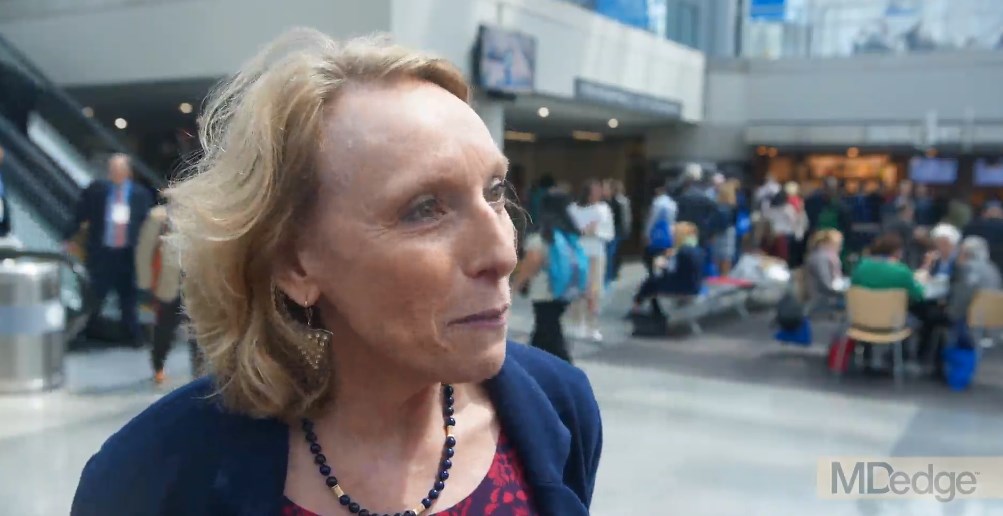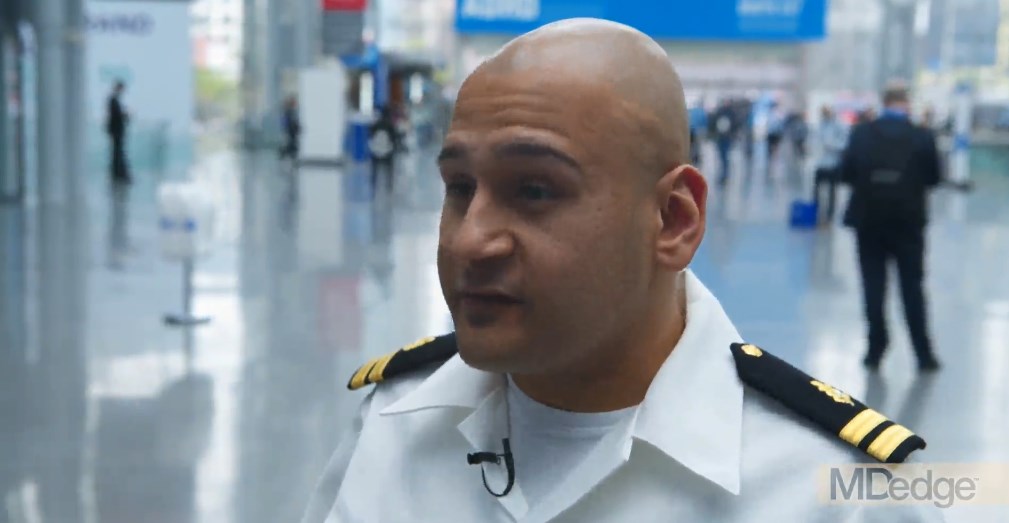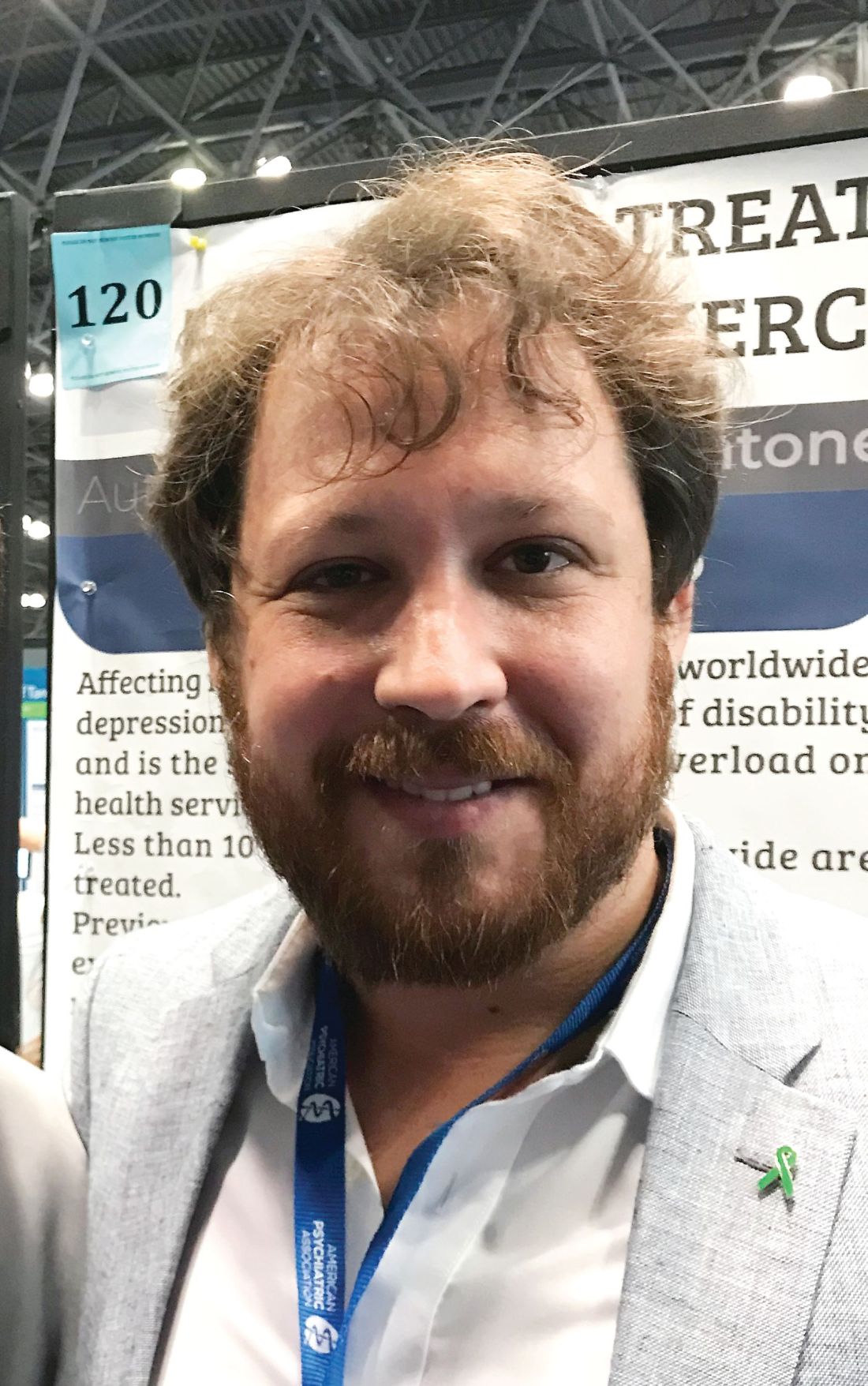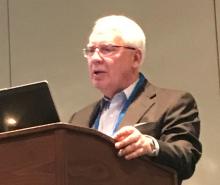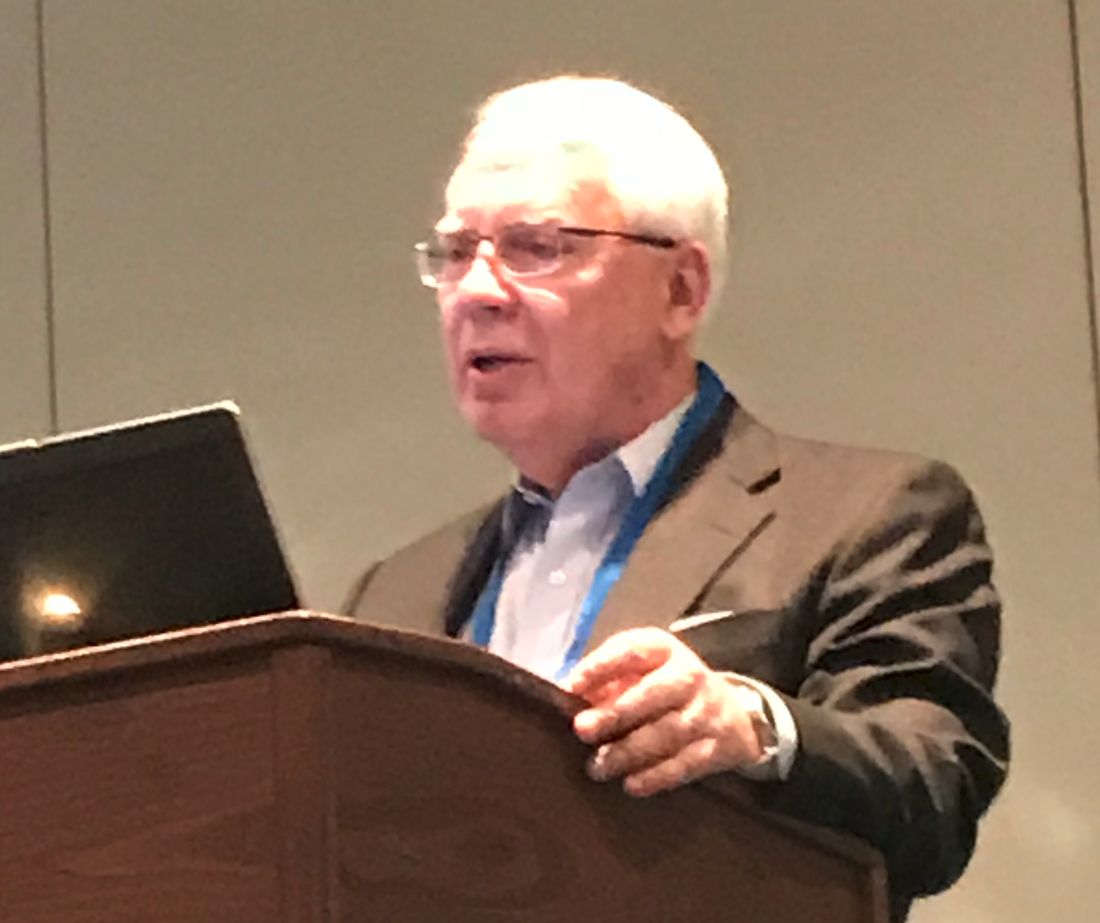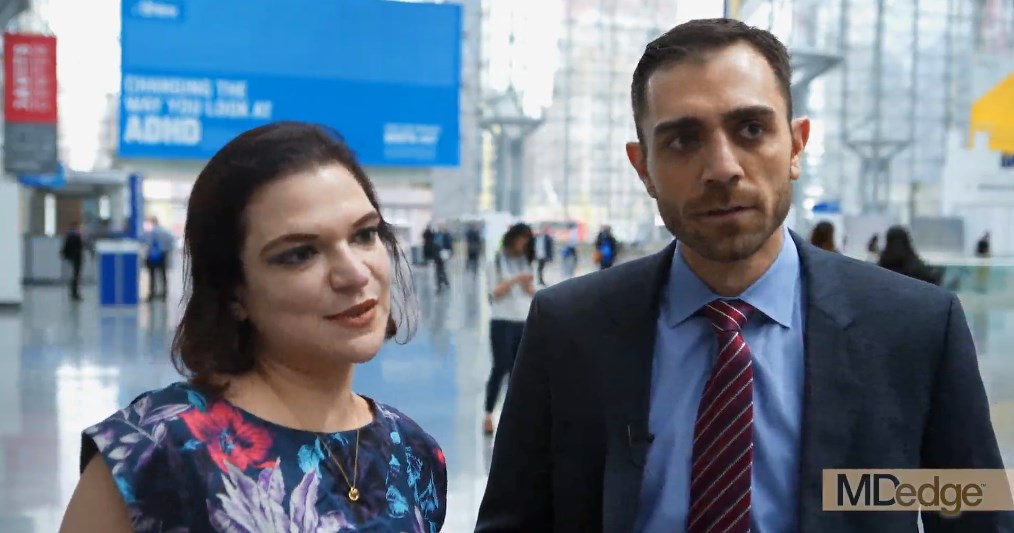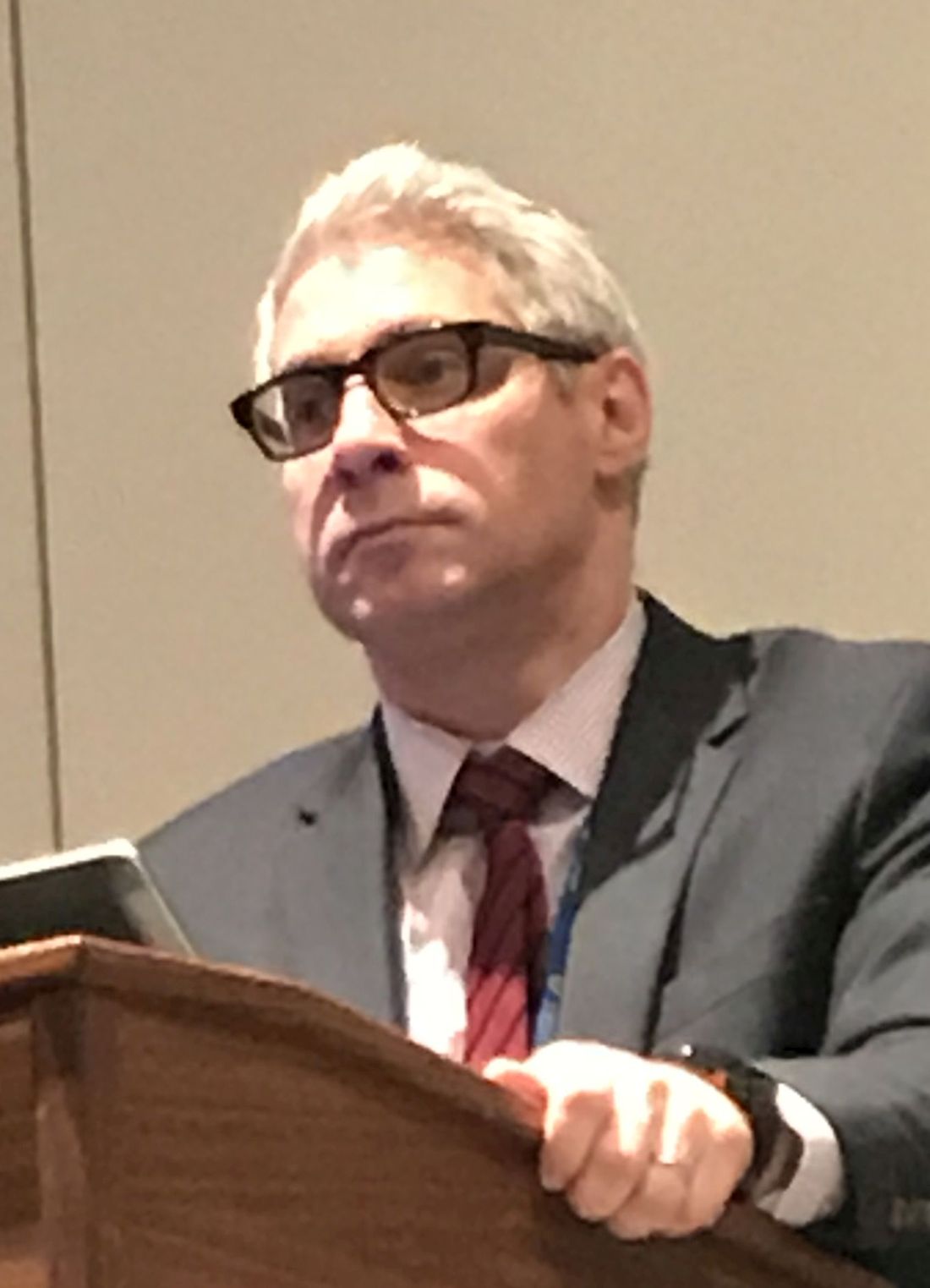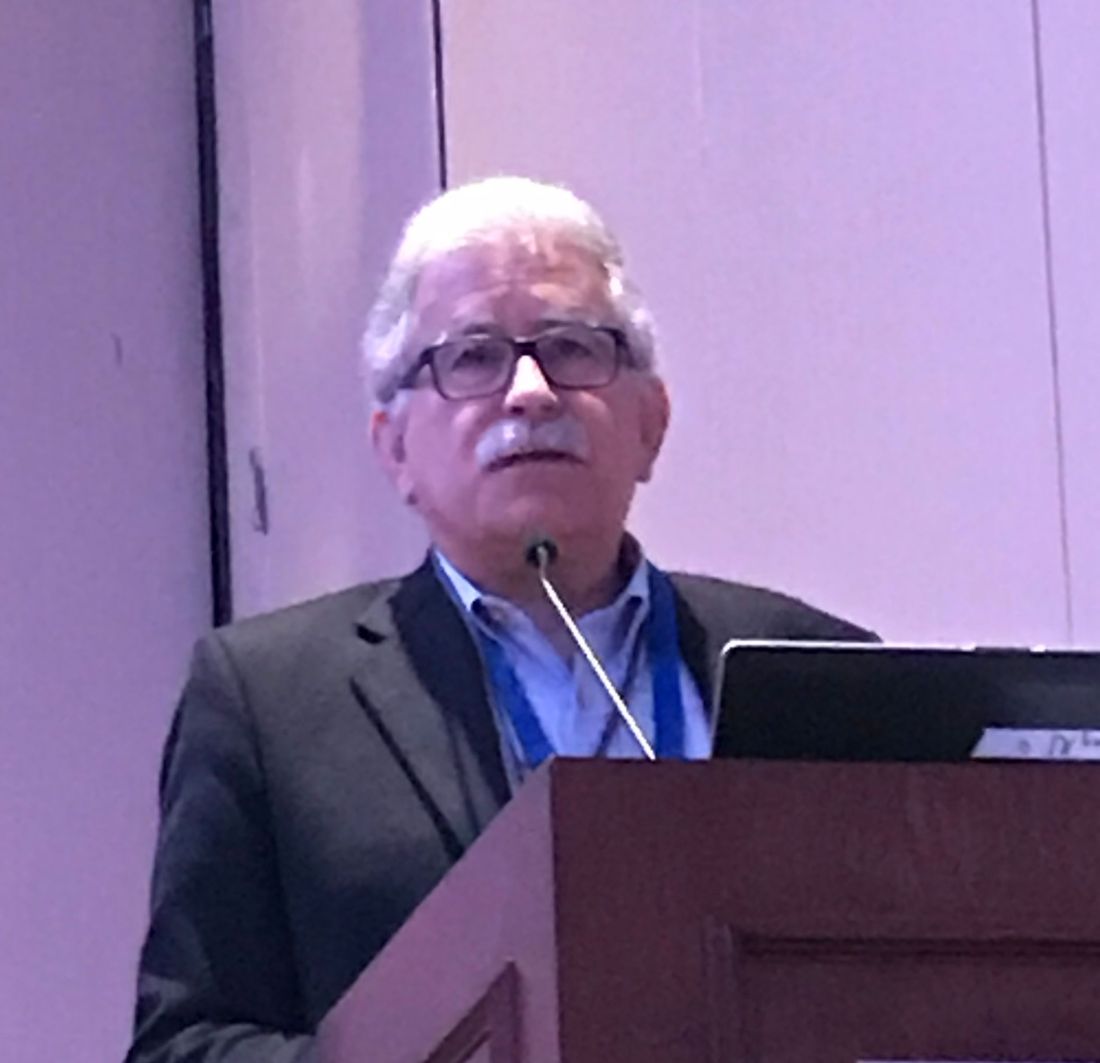User login
Peer mentorship, groups help combat burnout in female physicians
NEW YORK – Female physicians are at higher risk for burnout compared with their male counterparts, and the reasons and potential solutions for the problem were addressed at a symposium during the annual meeting of the American Psychiatric Association.
The work environment for women has improved over time, but lingering implicit and unconscious biases are part of the reason for the high burnout rate among women who are physicians, as are some inherent biological differences, according to Cynthia M. Stonnington, MD, of the Mayo Clinic, Phoenix.
In this video interview, Dr. Stonnington, symposium chair, discussed potential solutions, including facilitated peer mentorship and group support. She also reviewed recent data on how group support can be of benefit, and noted that “there is power in numbers.
“,” she said.
Dr. Stonnington reported having no disclosures.
NEW YORK – Female physicians are at higher risk for burnout compared with their male counterparts, and the reasons and potential solutions for the problem were addressed at a symposium during the annual meeting of the American Psychiatric Association.
The work environment for women has improved over time, but lingering implicit and unconscious biases are part of the reason for the high burnout rate among women who are physicians, as are some inherent biological differences, according to Cynthia M. Stonnington, MD, of the Mayo Clinic, Phoenix.
In this video interview, Dr. Stonnington, symposium chair, discussed potential solutions, including facilitated peer mentorship and group support. She also reviewed recent data on how group support can be of benefit, and noted that “there is power in numbers.
“,” she said.
Dr. Stonnington reported having no disclosures.
NEW YORK – Female physicians are at higher risk for burnout compared with their male counterparts, and the reasons and potential solutions for the problem were addressed at a symposium during the annual meeting of the American Psychiatric Association.
The work environment for women has improved over time, but lingering implicit and unconscious biases are part of the reason for the high burnout rate among women who are physicians, as are some inherent biological differences, according to Cynthia M. Stonnington, MD, of the Mayo Clinic, Phoenix.
In this video interview, Dr. Stonnington, symposium chair, discussed potential solutions, including facilitated peer mentorship and group support. She also reviewed recent data on how group support can be of benefit, and noted that “there is power in numbers.
“,” she said.
Dr. Stonnington reported having no disclosures.
REPORTING FROM APA
Link between alcohol consumption, neuroinflammation has possible treatment implications
NEW YORK – Recent discoveries regarding the relationship between alcohol consumption and neuroinflammation suggest a possible role for adjunctive treatments and supplements in addiction treatment, according to Shram Shukla, MD.
For example, a qualitative review of the literature over the past 2-3 years showed that the “neuroinflammatory process in and of itself drives epigenetic changes, which ultimately upregulate neuroinflammation of the brain,” according to Dr. Shukla of Walter Reed National Military Medical Center, Bethesda, Md., who reported the findings in a poster at the annual meeting of the American Psychiatric Association.
In this video interview, he explained that this finding is important because “neuroinflammation leads to neurotoxicity, which leads to neuronal degeneration.”
“As we know, with patients who chronically abuse alcohol, they do have a level of cortical degeneration that we often see on imaging, so there is, perhaps, a role that this may play in that,” he added.
Dr. Shukla said he also found that the neuroinflammatory process, when it drives the epigenetic changes, affects the amygdala, which is known as a “high stress part of the brain.”
“What we found in animal models so far is that if we can impact where that epigenetic change occurs, we can prevent the anxiogenic behaviors we often see in alcohol withdrawal and abstinence; we associate that, in humans, to be the high-stress state we often see in patients when they ... are withdrawing from alcohol.”
This raised questions about whether certain medications and supplements, including vitamin C, pioglitazone, infliximab, and omega-3 fatty acids, could be of benefit, and it was shown that these do affect neuroinflammation and stop neurotoxicity from occurring – and also, in turn, prevent the epigenetic changes, he said.
The take-away is that
“Now we have something, potentially ... that can do some of the ancillary stuff, working on the withdrawal effects, helping with the behavioral response that we see in patients that are suffering from addiction,” he said.
Dr. Shukla reported having no disclosures.
SOURCE: Shukla S et al. APA Poster Session 4, Poster 3.
NEW YORK – Recent discoveries regarding the relationship between alcohol consumption and neuroinflammation suggest a possible role for adjunctive treatments and supplements in addiction treatment, according to Shram Shukla, MD.
For example, a qualitative review of the literature over the past 2-3 years showed that the “neuroinflammatory process in and of itself drives epigenetic changes, which ultimately upregulate neuroinflammation of the brain,” according to Dr. Shukla of Walter Reed National Military Medical Center, Bethesda, Md., who reported the findings in a poster at the annual meeting of the American Psychiatric Association.
In this video interview, he explained that this finding is important because “neuroinflammation leads to neurotoxicity, which leads to neuronal degeneration.”
“As we know, with patients who chronically abuse alcohol, they do have a level of cortical degeneration that we often see on imaging, so there is, perhaps, a role that this may play in that,” he added.
Dr. Shukla said he also found that the neuroinflammatory process, when it drives the epigenetic changes, affects the amygdala, which is known as a “high stress part of the brain.”
“What we found in animal models so far is that if we can impact where that epigenetic change occurs, we can prevent the anxiogenic behaviors we often see in alcohol withdrawal and abstinence; we associate that, in humans, to be the high-stress state we often see in patients when they ... are withdrawing from alcohol.”
This raised questions about whether certain medications and supplements, including vitamin C, pioglitazone, infliximab, and omega-3 fatty acids, could be of benefit, and it was shown that these do affect neuroinflammation and stop neurotoxicity from occurring – and also, in turn, prevent the epigenetic changes, he said.
The take-away is that
“Now we have something, potentially ... that can do some of the ancillary stuff, working on the withdrawal effects, helping with the behavioral response that we see in patients that are suffering from addiction,” he said.
Dr. Shukla reported having no disclosures.
SOURCE: Shukla S et al. APA Poster Session 4, Poster 3.
NEW YORK – Recent discoveries regarding the relationship between alcohol consumption and neuroinflammation suggest a possible role for adjunctive treatments and supplements in addiction treatment, according to Shram Shukla, MD.
For example, a qualitative review of the literature over the past 2-3 years showed that the “neuroinflammatory process in and of itself drives epigenetic changes, which ultimately upregulate neuroinflammation of the brain,” according to Dr. Shukla of Walter Reed National Military Medical Center, Bethesda, Md., who reported the findings in a poster at the annual meeting of the American Psychiatric Association.
In this video interview, he explained that this finding is important because “neuroinflammation leads to neurotoxicity, which leads to neuronal degeneration.”
“As we know, with patients who chronically abuse alcohol, they do have a level of cortical degeneration that we often see on imaging, so there is, perhaps, a role that this may play in that,” he added.
Dr. Shukla said he also found that the neuroinflammatory process, when it drives the epigenetic changes, affects the amygdala, which is known as a “high stress part of the brain.”
“What we found in animal models so far is that if we can impact where that epigenetic change occurs, we can prevent the anxiogenic behaviors we often see in alcohol withdrawal and abstinence; we associate that, in humans, to be the high-stress state we often see in patients when they ... are withdrawing from alcohol.”
This raised questions about whether certain medications and supplements, including vitamin C, pioglitazone, infliximab, and omega-3 fatty acids, could be of benefit, and it was shown that these do affect neuroinflammation and stop neurotoxicity from occurring – and also, in turn, prevent the epigenetic changes, he said.
The take-away is that
“Now we have something, potentially ... that can do some of the ancillary stuff, working on the withdrawal effects, helping with the behavioral response that we see in patients that are suffering from addiction,” he said.
Dr. Shukla reported having no disclosures.
SOURCE: Shukla S et al. APA Poster Session 4, Poster 3.
REPORTING FROM APA
Cultural sensitivity key to delivering effective psychiatric care
NEW YORK – A mental health clinic started for an urban Hispanic community in Connecticut in 1972 continues to generate lessons on how to apply cultural sensitivity to improve care, according to a critical assessment of the program presented at the annual meeting of the American Psychiatric Association.
“Reviews of the literature show that there is a difference when clinicians are culturally responsive and sensitive to the populations they serve,” reported Esperanza Díaz, MD, of the department of psychiatry at Yale University and medical director, Latino Behavioral Health System (LBHS), both in New Haven, Conn.
“How can I talk about depression treatment to a patient who does not have a place to live?” Dr. Díaz asked. Citing a variety of evidence that links mental health to social issues, Dr. Díaz explained, “We learned to partner with everyone in the community to achieve treatment goals.”
By “everyone,” Dr. Díaz was referring to primary care clinicians, family members, church community groups, social support groups, and even local politicians. She also credited success to peer counselors, which are prior patients trained to provide supportive care. Not least important, family members are recruited to help.
“In the Latino community, family is central to identity,” Dr. Díaz explained. One of treatment goals is to help patients reestablish ties with family and other community members who were lost during a mental health crisis. For this task, peer counselors have proven particularly effective for mitigating stigma and providing guidance.
All of these strategies are relevant to cultural competence, a concept for delivering effective mental health services that received particular attention in the DSM-5. Of strategies and tools relevant to this topic in the DSM-5, Dr. Díaz indicated that the Cultural Formulation Interview (CFI) should be considered particularly important for aiding clinicians in understanding mental health issues in a cultural context.
“For us as psychiatrists, the interview is our tool. ” Dr. Díaz asked. She led a recent study demonstrating that the CFI can help clinicians identify unique needs and preferences in a Hispanic population (Psychiatr Serv. 2017 Feb 1;68[2]:112-4). She said the principles of the CFI are relevant to any cultural group.
For evaluating and demonstrating efficacy of mental health services developed for a target cultural group, Dr. Díaz recommended identifying goals and then performance measures to track success. At her own center, quarterly reports track effectiveness and communicate value to the community and those providing funding its activities.
In the period during 2008-2017, 950 adult patients received mental health or substance use services from LBHS, Dr. Díaz reported. In addition to the full-time staff, LBHS has provided training to social workers and psychologists. In addition, 11 psychiatric residents in their third or fourth year of training have worked in LBHS during this period. Many of the peer counselors trained at LBHS have been hired away because of the skills they acquired.
Of the many elements that Dr. Díaz believes are important to the success of the LBHS, “confianza” has provided a key to patient willingness to stay with care through recovery. This word, Spanish for trust, recognizes that patients must have confidence in the ability of clinicians to understand and resolve their problems.
Recognizing the importance of collaborating with the community to design effective therapy, Dr. Díaz also emphasized the importance of humility to the success of LBHS.
“Humility to accept recommendations from people who are not supposedly experts, like family members,” Dr. Díaz said. “We learned that we need to know how to partner.”
NEW YORK – A mental health clinic started for an urban Hispanic community in Connecticut in 1972 continues to generate lessons on how to apply cultural sensitivity to improve care, according to a critical assessment of the program presented at the annual meeting of the American Psychiatric Association.
“Reviews of the literature show that there is a difference when clinicians are culturally responsive and sensitive to the populations they serve,” reported Esperanza Díaz, MD, of the department of psychiatry at Yale University and medical director, Latino Behavioral Health System (LBHS), both in New Haven, Conn.
“How can I talk about depression treatment to a patient who does not have a place to live?” Dr. Díaz asked. Citing a variety of evidence that links mental health to social issues, Dr. Díaz explained, “We learned to partner with everyone in the community to achieve treatment goals.”
By “everyone,” Dr. Díaz was referring to primary care clinicians, family members, church community groups, social support groups, and even local politicians. She also credited success to peer counselors, which are prior patients trained to provide supportive care. Not least important, family members are recruited to help.
“In the Latino community, family is central to identity,” Dr. Díaz explained. One of treatment goals is to help patients reestablish ties with family and other community members who were lost during a mental health crisis. For this task, peer counselors have proven particularly effective for mitigating stigma and providing guidance.
All of these strategies are relevant to cultural competence, a concept for delivering effective mental health services that received particular attention in the DSM-5. Of strategies and tools relevant to this topic in the DSM-5, Dr. Díaz indicated that the Cultural Formulation Interview (CFI) should be considered particularly important for aiding clinicians in understanding mental health issues in a cultural context.
“For us as psychiatrists, the interview is our tool. ” Dr. Díaz asked. She led a recent study demonstrating that the CFI can help clinicians identify unique needs and preferences in a Hispanic population (Psychiatr Serv. 2017 Feb 1;68[2]:112-4). She said the principles of the CFI are relevant to any cultural group.
For evaluating and demonstrating efficacy of mental health services developed for a target cultural group, Dr. Díaz recommended identifying goals and then performance measures to track success. At her own center, quarterly reports track effectiveness and communicate value to the community and those providing funding its activities.
In the period during 2008-2017, 950 adult patients received mental health or substance use services from LBHS, Dr. Díaz reported. In addition to the full-time staff, LBHS has provided training to social workers and psychologists. In addition, 11 psychiatric residents in their third or fourth year of training have worked in LBHS during this period. Many of the peer counselors trained at LBHS have been hired away because of the skills they acquired.
Of the many elements that Dr. Díaz believes are important to the success of the LBHS, “confianza” has provided a key to patient willingness to stay with care through recovery. This word, Spanish for trust, recognizes that patients must have confidence in the ability of clinicians to understand and resolve their problems.
Recognizing the importance of collaborating with the community to design effective therapy, Dr. Díaz also emphasized the importance of humility to the success of LBHS.
“Humility to accept recommendations from people who are not supposedly experts, like family members,” Dr. Díaz said. “We learned that we need to know how to partner.”
NEW YORK – A mental health clinic started for an urban Hispanic community in Connecticut in 1972 continues to generate lessons on how to apply cultural sensitivity to improve care, according to a critical assessment of the program presented at the annual meeting of the American Psychiatric Association.
“Reviews of the literature show that there is a difference when clinicians are culturally responsive and sensitive to the populations they serve,” reported Esperanza Díaz, MD, of the department of psychiatry at Yale University and medical director, Latino Behavioral Health System (LBHS), both in New Haven, Conn.
“How can I talk about depression treatment to a patient who does not have a place to live?” Dr. Díaz asked. Citing a variety of evidence that links mental health to social issues, Dr. Díaz explained, “We learned to partner with everyone in the community to achieve treatment goals.”
By “everyone,” Dr. Díaz was referring to primary care clinicians, family members, church community groups, social support groups, and even local politicians. She also credited success to peer counselors, which are prior patients trained to provide supportive care. Not least important, family members are recruited to help.
“In the Latino community, family is central to identity,” Dr. Díaz explained. One of treatment goals is to help patients reestablish ties with family and other community members who were lost during a mental health crisis. For this task, peer counselors have proven particularly effective for mitigating stigma and providing guidance.
All of these strategies are relevant to cultural competence, a concept for delivering effective mental health services that received particular attention in the DSM-5. Of strategies and tools relevant to this topic in the DSM-5, Dr. Díaz indicated that the Cultural Formulation Interview (CFI) should be considered particularly important for aiding clinicians in understanding mental health issues in a cultural context.
“For us as psychiatrists, the interview is our tool. ” Dr. Díaz asked. She led a recent study demonstrating that the CFI can help clinicians identify unique needs and preferences in a Hispanic population (Psychiatr Serv. 2017 Feb 1;68[2]:112-4). She said the principles of the CFI are relevant to any cultural group.
For evaluating and demonstrating efficacy of mental health services developed for a target cultural group, Dr. Díaz recommended identifying goals and then performance measures to track success. At her own center, quarterly reports track effectiveness and communicate value to the community and those providing funding its activities.
In the period during 2008-2017, 950 adult patients received mental health or substance use services from LBHS, Dr. Díaz reported. In addition to the full-time staff, LBHS has provided training to social workers and psychologists. In addition, 11 psychiatric residents in their third or fourth year of training have worked in LBHS during this period. Many of the peer counselors trained at LBHS have been hired away because of the skills they acquired.
Of the many elements that Dr. Díaz believes are important to the success of the LBHS, “confianza” has provided a key to patient willingness to stay with care through recovery. This word, Spanish for trust, recognizes that patients must have confidence in the ability of clinicians to understand and resolve their problems.
Recognizing the importance of collaborating with the community to design effective therapy, Dr. Díaz also emphasized the importance of humility to the success of LBHS.
“Humility to accept recommendations from people who are not supposedly experts, like family members,” Dr. Díaz said. “We learned that we need to know how to partner.”
REPORTING FROM APA
Legalization of marijuana debate moving away from medical need
NEW YORK – The risk curve of societal harm from marijuana when graphed from a policy of complete prohibition to one of unregulated access is U shaped, according to a panel of experts who participated in a workshop on the harms and benefits of cannabis at the annual meeting of the American Psychiatric Association.
Based on more than 80 years of experience, it is clear that prohibition supports criminal activity but does not eliminate use, said Jason Hershberger, MD, chair of the department of psychiatry at Brookdale University Hospital Medical Center, New York. With progressive degrees of decriminalization, the harms to society associated with criminal distribution and the criminalization of use decreases, but they are replaced with increasing societal risks imposed by the availability of an intoxicating substance.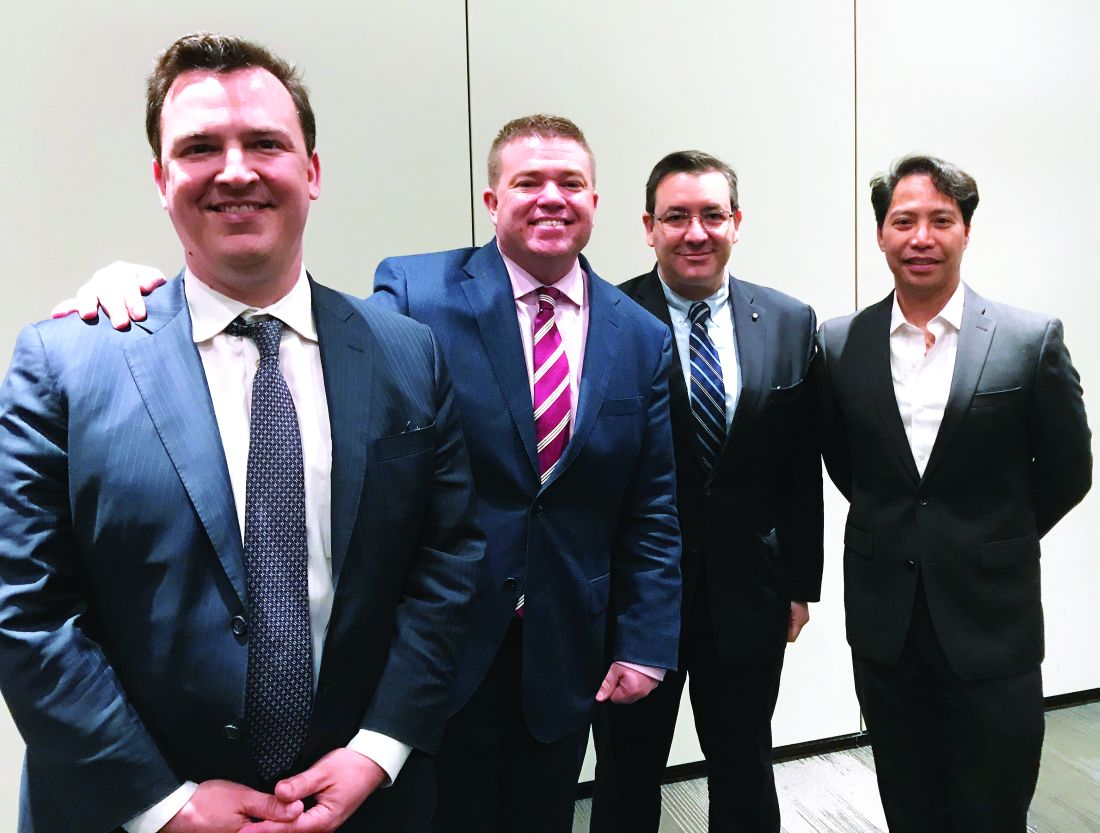
Theoretically, one argument is that the inflection point occurs where cannabis has been decriminalized for medical indications but prohibited for recreational use. But this is a tenuous position. Clinicians, including psychiatrists, might support the use of cannabis to reduce stress, but it is well known that the pleasant intoxication provided by cannabis is relaxing – whether or not this is characterized as stress relief.
reported Stephan M. Carlson, MD, who also is affiliated with Brookdale University Hospital Medical Center. Based on his belief that marijuana, after alcohol and tobacco, may soon be the third legal drug where it isn’t already, “physicians have just a temporary role” in mediating the debate about medical legalization from a legal or political standpoint. Why? Because this part of the debate is growing irrelevant.
This does not mean medical indications or medical harms are not valid topics of discussion, Dr. Hershberger and Dr. Carlson said. The problem is that recreational use is supplanting medical use as the central issue in making this drug available.
The road toward U.S. legalization started in 1996, when California voters approved the use of marijuana for medical indications. Other states followed. Then, in 2012, Colorado and Washington became the first states to approve the drug for recreational use. In total, 29 states now permit some form of legal use of marijuana. In addition, marijuana possession has been decriminalized in several states where it remains illegal.
“From the federal perspective, marijuana is still a Schedule I drug. This means that it is easier to conduct research on cocaine, which is a Schedule II drug, than it is on marijuana,” Dr. Hershberger said. While the current presidential administration has adopted a tougher stance on distribution and use of marijuana than the previous, more than 60% of Americans in surveys support decriminalization of marijuana, according to Dr. Hershberger. He suggested that the current acceptability of marijuana is the reason that a recent survey indicated that more U.S. high school seniors than ever before have tried marijuana.
In light of the perceptions that the marijuana ban was ineffective, that marijuana is acceptable, and that profits from marijuana sales and distributions have been going to criminals, depriving government of tax dollars, continued decriminalization appears to be inevitable, Dr. Hershberger said. However, he believes that complete deregulation poses important risk, including an inevitable increase in accidents produced by motor impairment. It is also reasonable to anticipate more substance use in vulnerable populations. The risk to the development of children and adolescents who are likely to gain easier access to cannabis is unknown.
For psychiatrists and other medical specialists who wish to participate in the debate about the degree to which marijuana is decriminalized, both Dr. Hershberger and Dr. Carlson argued that a clear and realistic view of the landscape is essential.
“One of the reasons we are in this state we are in is that many people have declared the war on drugs a failure,” Dr. Hershberger said. Although he acknowledged that recognizing the limited efficacy of a marijuana ban is a reasonable starting point for discussion, he also expressed concern about large corporations being permitted to market cannabis in a way that obscures its risks or encourages use by those at greatest risk of harm, such as minors.
“We have to ask ourselves, is America ready for a cannabis commercial during the Super Bowl?” Dr. Hershberger said. He believes that an important trade-off exists for risks regardless of the degree to which marijuana is legalized.
“We have to approach this in the context of our current reality,” Dr. Carlson agreed. He, like Dr. Hershberger, cautioned that there are no simple answers.
Dr. Hershberger and Dr. Carlson reported no potential conflicts of interest.
NEW YORK – The risk curve of societal harm from marijuana when graphed from a policy of complete prohibition to one of unregulated access is U shaped, according to a panel of experts who participated in a workshop on the harms and benefits of cannabis at the annual meeting of the American Psychiatric Association.
Based on more than 80 years of experience, it is clear that prohibition supports criminal activity but does not eliminate use, said Jason Hershberger, MD, chair of the department of psychiatry at Brookdale University Hospital Medical Center, New York. With progressive degrees of decriminalization, the harms to society associated with criminal distribution and the criminalization of use decreases, but they are replaced with increasing societal risks imposed by the availability of an intoxicating substance.
Theoretically, one argument is that the inflection point occurs where cannabis has been decriminalized for medical indications but prohibited for recreational use. But this is a tenuous position. Clinicians, including psychiatrists, might support the use of cannabis to reduce stress, but it is well known that the pleasant intoxication provided by cannabis is relaxing – whether or not this is characterized as stress relief.
reported Stephan M. Carlson, MD, who also is affiliated with Brookdale University Hospital Medical Center. Based on his belief that marijuana, after alcohol and tobacco, may soon be the third legal drug where it isn’t already, “physicians have just a temporary role” in mediating the debate about medical legalization from a legal or political standpoint. Why? Because this part of the debate is growing irrelevant.
This does not mean medical indications or medical harms are not valid topics of discussion, Dr. Hershberger and Dr. Carlson said. The problem is that recreational use is supplanting medical use as the central issue in making this drug available.
The road toward U.S. legalization started in 1996, when California voters approved the use of marijuana for medical indications. Other states followed. Then, in 2012, Colorado and Washington became the first states to approve the drug for recreational use. In total, 29 states now permit some form of legal use of marijuana. In addition, marijuana possession has been decriminalized in several states where it remains illegal.
“From the federal perspective, marijuana is still a Schedule I drug. This means that it is easier to conduct research on cocaine, which is a Schedule II drug, than it is on marijuana,” Dr. Hershberger said. While the current presidential administration has adopted a tougher stance on distribution and use of marijuana than the previous, more than 60% of Americans in surveys support decriminalization of marijuana, according to Dr. Hershberger. He suggested that the current acceptability of marijuana is the reason that a recent survey indicated that more U.S. high school seniors than ever before have tried marijuana.
In light of the perceptions that the marijuana ban was ineffective, that marijuana is acceptable, and that profits from marijuana sales and distributions have been going to criminals, depriving government of tax dollars, continued decriminalization appears to be inevitable, Dr. Hershberger said. However, he believes that complete deregulation poses important risk, including an inevitable increase in accidents produced by motor impairment. It is also reasonable to anticipate more substance use in vulnerable populations. The risk to the development of children and adolescents who are likely to gain easier access to cannabis is unknown.
For psychiatrists and other medical specialists who wish to participate in the debate about the degree to which marijuana is decriminalized, both Dr. Hershberger and Dr. Carlson argued that a clear and realistic view of the landscape is essential.
“One of the reasons we are in this state we are in is that many people have declared the war on drugs a failure,” Dr. Hershberger said. Although he acknowledged that recognizing the limited efficacy of a marijuana ban is a reasonable starting point for discussion, he also expressed concern about large corporations being permitted to market cannabis in a way that obscures its risks or encourages use by those at greatest risk of harm, such as minors.
“We have to ask ourselves, is America ready for a cannabis commercial during the Super Bowl?” Dr. Hershberger said. He believes that an important trade-off exists for risks regardless of the degree to which marijuana is legalized.
“We have to approach this in the context of our current reality,” Dr. Carlson agreed. He, like Dr. Hershberger, cautioned that there are no simple answers.
Dr. Hershberger and Dr. Carlson reported no potential conflicts of interest.
NEW YORK – The risk curve of societal harm from marijuana when graphed from a policy of complete prohibition to one of unregulated access is U shaped, according to a panel of experts who participated in a workshop on the harms and benefits of cannabis at the annual meeting of the American Psychiatric Association.
Based on more than 80 years of experience, it is clear that prohibition supports criminal activity but does not eliminate use, said Jason Hershberger, MD, chair of the department of psychiatry at Brookdale University Hospital Medical Center, New York. With progressive degrees of decriminalization, the harms to society associated with criminal distribution and the criminalization of use decreases, but they are replaced with increasing societal risks imposed by the availability of an intoxicating substance.
Theoretically, one argument is that the inflection point occurs where cannabis has been decriminalized for medical indications but prohibited for recreational use. But this is a tenuous position. Clinicians, including psychiatrists, might support the use of cannabis to reduce stress, but it is well known that the pleasant intoxication provided by cannabis is relaxing – whether or not this is characterized as stress relief.
reported Stephan M. Carlson, MD, who also is affiliated with Brookdale University Hospital Medical Center. Based on his belief that marijuana, after alcohol and tobacco, may soon be the third legal drug where it isn’t already, “physicians have just a temporary role” in mediating the debate about medical legalization from a legal or political standpoint. Why? Because this part of the debate is growing irrelevant.
This does not mean medical indications or medical harms are not valid topics of discussion, Dr. Hershberger and Dr. Carlson said. The problem is that recreational use is supplanting medical use as the central issue in making this drug available.
The road toward U.S. legalization started in 1996, when California voters approved the use of marijuana for medical indications. Other states followed. Then, in 2012, Colorado and Washington became the first states to approve the drug for recreational use. In total, 29 states now permit some form of legal use of marijuana. In addition, marijuana possession has been decriminalized in several states where it remains illegal.
“From the federal perspective, marijuana is still a Schedule I drug. This means that it is easier to conduct research on cocaine, which is a Schedule II drug, than it is on marijuana,” Dr. Hershberger said. While the current presidential administration has adopted a tougher stance on distribution and use of marijuana than the previous, more than 60% of Americans in surveys support decriminalization of marijuana, according to Dr. Hershberger. He suggested that the current acceptability of marijuana is the reason that a recent survey indicated that more U.S. high school seniors than ever before have tried marijuana.
In light of the perceptions that the marijuana ban was ineffective, that marijuana is acceptable, and that profits from marijuana sales and distributions have been going to criminals, depriving government of tax dollars, continued decriminalization appears to be inevitable, Dr. Hershberger said. However, he believes that complete deregulation poses important risk, including an inevitable increase in accidents produced by motor impairment. It is also reasonable to anticipate more substance use in vulnerable populations. The risk to the development of children and adolescents who are likely to gain easier access to cannabis is unknown.
For psychiatrists and other medical specialists who wish to participate in the debate about the degree to which marijuana is decriminalized, both Dr. Hershberger and Dr. Carlson argued that a clear and realistic view of the landscape is essential.
“One of the reasons we are in this state we are in is that many people have declared the war on drugs a failure,” Dr. Hershberger said. Although he acknowledged that recognizing the limited efficacy of a marijuana ban is a reasonable starting point for discussion, he also expressed concern about large corporations being permitted to market cannabis in a way that obscures its risks or encourages use by those at greatest risk of harm, such as minors.
“We have to ask ourselves, is America ready for a cannabis commercial during the Super Bowl?” Dr. Hershberger said. He believes that an important trade-off exists for risks regardless of the degree to which marijuana is legalized.
“We have to approach this in the context of our current reality,” Dr. Carlson agreed. He, like Dr. Hershberger, cautioned that there are no simple answers.
Dr. Hershberger and Dr. Carlson reported no potential conflicts of interest.
EXPERT ANALYSIS FROM APA
Simple postural exercises may reduce depressive symptoms
NEW YORK – Postural exercises that take only a few minutes but are performed several times a day produced large reductions in symptoms of depression and increased the rate of remission at 12 weeks, according to results of a randomized study presented at the annual meeting of the American Psychiatric Association.
“These were very marked symptom improvements seen at the end of 12 weeks in those randomized to the exercises when compared to the controls who received antidepressants alone,” reported Martin Furman, MD, a researcher in psychiatry at the University of Maimónides, Buenos Aires.
The patients in this study all continued on their baseline SSRI dose but were randomized to start postural exercises or to remain on an SSRI alone. The two sets of exercises, which took only a couple of minutes, were repeated four to six times per day with at least 2 hours of separation.
The equilibrium exercises involved raised arms with flexing of first one lower limb then the other. Each flex was maintained for 15 seconds. In a separate exercise, patients were instructed to hold a pencil between the teeth and smile for 1 minute, a technique that activates facial skin afferents, according to Dr. Furman.
“In previous studies, posture and balance have been linked to a reduction in anxiety and moderate depression,” Dr. Furman explained. “Feedback of the muscular and facial skin afferents has been associated with modulation of neural activity within the central circuit of emotions.”
Much of this work was pioneered by Tomás Ortiz Alonso, MD, PhD, director of the department of psychiatry at Universidad Complutense de Madrid, according to Dr. Furman. While working to complete his PhD, Dr. Furman is collaborating with Dr. Ortiz Alonso.
Patients participating in the study were evaluated with the Beck Depression Inventory (BDI) and the 17-item Hamilton Depression Rating Scale (HDRS-17) at baseline and the end of 12 weeks. Response for both scales was defined as at least a 50% score reduction from baseline. Remission of depression was defined as HDRS-17 score of less than 7.
At 12 weeks, 86% of those in the experimental arm versus 28.5% of those in the control arm achieved a response on the HDRS-17 tool. For the BDI tool, the response rates were 71.5% and 19%, respectively. The remission rates as defined by HDRS-17 score of less than 7 were 66.6% and 19%. All differences were statistically significant (P less than .05).
“The exercises are simple and take very little time,” said Dr. Furman, who reported that compliance was good in the study arm according to patient self-report.
There are numerous published studies suggesting that exercise improves mood in a variety of circumstances, including the treatment of depression, and Dr. Furman said these exercises are not physically demanding. If larger studies validate the results of this initial trial, this might prove to be a highly cost-effective tool for depression treatment.
“Further studies are needed to determine whether these exercises are most effective as adjunctive treatment to pharmacotherapy or can be used alone without medications,” he said.
In addition to larger efficacy studies, Dr. Furman reported that efforts to understand the mechanism of benefit are being considered, such as studies with functional MRI or EEG to evaluate the effect of the exercises on brain activity.
“We are excited about these results. ,” he said.
Dr. Furman reports no potential conflicts of interest related to this topic.
NEW YORK – Postural exercises that take only a few minutes but are performed several times a day produced large reductions in symptoms of depression and increased the rate of remission at 12 weeks, according to results of a randomized study presented at the annual meeting of the American Psychiatric Association.
“These were very marked symptom improvements seen at the end of 12 weeks in those randomized to the exercises when compared to the controls who received antidepressants alone,” reported Martin Furman, MD, a researcher in psychiatry at the University of Maimónides, Buenos Aires.
The patients in this study all continued on their baseline SSRI dose but were randomized to start postural exercises or to remain on an SSRI alone. The two sets of exercises, which took only a couple of minutes, were repeated four to six times per day with at least 2 hours of separation.
The equilibrium exercises involved raised arms with flexing of first one lower limb then the other. Each flex was maintained for 15 seconds. In a separate exercise, patients were instructed to hold a pencil between the teeth and smile for 1 minute, a technique that activates facial skin afferents, according to Dr. Furman.
“In previous studies, posture and balance have been linked to a reduction in anxiety and moderate depression,” Dr. Furman explained. “Feedback of the muscular and facial skin afferents has been associated with modulation of neural activity within the central circuit of emotions.”
Much of this work was pioneered by Tomás Ortiz Alonso, MD, PhD, director of the department of psychiatry at Universidad Complutense de Madrid, according to Dr. Furman. While working to complete his PhD, Dr. Furman is collaborating with Dr. Ortiz Alonso.
Patients participating in the study were evaluated with the Beck Depression Inventory (BDI) and the 17-item Hamilton Depression Rating Scale (HDRS-17) at baseline and the end of 12 weeks. Response for both scales was defined as at least a 50% score reduction from baseline. Remission of depression was defined as HDRS-17 score of less than 7.
At 12 weeks, 86% of those in the experimental arm versus 28.5% of those in the control arm achieved a response on the HDRS-17 tool. For the BDI tool, the response rates were 71.5% and 19%, respectively. The remission rates as defined by HDRS-17 score of less than 7 were 66.6% and 19%. All differences were statistically significant (P less than .05).
“The exercises are simple and take very little time,” said Dr. Furman, who reported that compliance was good in the study arm according to patient self-report.
There are numerous published studies suggesting that exercise improves mood in a variety of circumstances, including the treatment of depression, and Dr. Furman said these exercises are not physically demanding. If larger studies validate the results of this initial trial, this might prove to be a highly cost-effective tool for depression treatment.
“Further studies are needed to determine whether these exercises are most effective as adjunctive treatment to pharmacotherapy or can be used alone without medications,” he said.
In addition to larger efficacy studies, Dr. Furman reported that efforts to understand the mechanism of benefit are being considered, such as studies with functional MRI or EEG to evaluate the effect of the exercises on brain activity.
“We are excited about these results. ,” he said.
Dr. Furman reports no potential conflicts of interest related to this topic.
NEW YORK – Postural exercises that take only a few minutes but are performed several times a day produced large reductions in symptoms of depression and increased the rate of remission at 12 weeks, according to results of a randomized study presented at the annual meeting of the American Psychiatric Association.
“These were very marked symptom improvements seen at the end of 12 weeks in those randomized to the exercises when compared to the controls who received antidepressants alone,” reported Martin Furman, MD, a researcher in psychiatry at the University of Maimónides, Buenos Aires.
The patients in this study all continued on their baseline SSRI dose but were randomized to start postural exercises or to remain on an SSRI alone. The two sets of exercises, which took only a couple of minutes, were repeated four to six times per day with at least 2 hours of separation.
The equilibrium exercises involved raised arms with flexing of first one lower limb then the other. Each flex was maintained for 15 seconds. In a separate exercise, patients were instructed to hold a pencil between the teeth and smile for 1 minute, a technique that activates facial skin afferents, according to Dr. Furman.
“In previous studies, posture and balance have been linked to a reduction in anxiety and moderate depression,” Dr. Furman explained. “Feedback of the muscular and facial skin afferents has been associated with modulation of neural activity within the central circuit of emotions.”
Much of this work was pioneered by Tomás Ortiz Alonso, MD, PhD, director of the department of psychiatry at Universidad Complutense de Madrid, according to Dr. Furman. While working to complete his PhD, Dr. Furman is collaborating with Dr. Ortiz Alonso.
Patients participating in the study were evaluated with the Beck Depression Inventory (BDI) and the 17-item Hamilton Depression Rating Scale (HDRS-17) at baseline and the end of 12 weeks. Response for both scales was defined as at least a 50% score reduction from baseline. Remission of depression was defined as HDRS-17 score of less than 7.
At 12 weeks, 86% of those in the experimental arm versus 28.5% of those in the control arm achieved a response on the HDRS-17 tool. For the BDI tool, the response rates were 71.5% and 19%, respectively. The remission rates as defined by HDRS-17 score of less than 7 were 66.6% and 19%. All differences were statistically significant (P less than .05).
“The exercises are simple and take very little time,” said Dr. Furman, who reported that compliance was good in the study arm according to patient self-report.
There are numerous published studies suggesting that exercise improves mood in a variety of circumstances, including the treatment of depression, and Dr. Furman said these exercises are not physically demanding. If larger studies validate the results of this initial trial, this might prove to be a highly cost-effective tool for depression treatment.
“Further studies are needed to determine whether these exercises are most effective as adjunctive treatment to pharmacotherapy or can be used alone without medications,” he said.
In addition to larger efficacy studies, Dr. Furman reported that efforts to understand the mechanism of benefit are being considered, such as studies with functional MRI or EEG to evaluate the effect of the exercises on brain activity.
“We are excited about these results. ,” he said.
Dr. Furman reports no potential conflicts of interest related to this topic.
REPORTING FROM APA
Key clinical point: In patients with major depression, a simple set of daily postural exercises appears effective for improving symptom control.
Major finding: After 12 weeks, 67% of those performing exercises versus 19% of controls (P less than .05) met criteria for depression remission.
Study details: Randomized, controlled trial of 42 patients who met DSM-5 criteria for major depressive disorder.
Disclosures: Dr. Furman reports no potential conflicts of interest related to this topic.
Cultural humility beats competence in psychotherapeutic settings
The emphasis on cultural context of diagnosis and treatment of psychiatric disorders was expanded in the DSM-5, but the commonly used term for this orientation, “cultural competence,” is potentially misleading, according to a panel of experienced clinicians participating in a workshop at the annual meeting of the American Psychiatric Association.
“I am not even sure how competent I am in my own culture,” said Richa Bhatia, MD, medical director of the Child and Adolescent OCD Institute at McLean Hospital, Belmont, Mass.. The remark was representative; like other panelists in a workshop developed by the Association of Women Psychiatrists, she de-emphasized the importance of becoming fluent in the specifics of a culture relative to simply being sensitive to variations in cultural landmarks and milestones.
However, she, like others, expressed concern about the label “competence.” “Cultural humility is really a much better term,” Dr. Olarte said. The reason is that Furthermore, it encourages clinicians to consider and manage their own prejudices, values, and biases in order to allow them to be effective in the therapeutic interaction.
In the DSM-5, a systematic outline is provided for eliciting culturally relevant information from the diagnostic interview and incorporating it into a therapeutic plan. Cultural competence is important for communication and for building patient trust, but the panelists uniformly agreed that it is not necessary to be fluent in the culture of the patient to be an effective clinician.
“Cultural identification is fluid, and patients have multiple identities,” said Lourdes M. Dominguez, MD, associate professor of psychiatry at Columbia University, New York. Recounting her work with first responders to the Sept. 11, 2001, World Trade Center attack, Dr. Dominguez offered care to police officers associated with a variety of cultures. In addition to different ethnicities and sexual orientations, this included the culture of law enforcement itself. The key for all patients was an ability to convey the message that the patient was being heard.
“The us-versus-them mentality in law enforcement limits the options when fellow officers are not providing the support they need,” Dr. Dominguez explained. “First, you need to win their trust.”
Familiarity with cultural milestones can be reassuring to patients, but Sherry P. Katz-Bearnot, MD, assistant clinical professor of psychiatry at Columbia University, cautioned that there is counterproductive underside to cultural competence. While recognizing the significance of cultural milestones, such as a bar mitvah or quinceañera, can be reassuring to patients, Dr. Katz-Bearnot emphasized that clinicians must remain sensitive to the personal responses to those events.
“If you know too much, there is a risk of glossing over the issues unique to the individual in front of you,” Dr. Katz-Bearnot said. She emphasized that those cultural landmarks do not necessarily mean the same thing to all members of a community. Sensitivity to personal issues trumps cultural familiarity.
The same statement could be made for delivering care to transgender patients, judging from a presentation by Courtney Saw, MD, a PGY3 resident in the department of psychiatry at the University of Pennsylvania, Philadelphia. Quoting a survey that found most transgender individuals consider health care professionals inadequately trained to manage their health issues, she stressed the importance of how questions are phrased.
“Every patient’s gender journey is unique,” Dr. Saw said. For example, specific questions about gender anatomy should be supplanted by open questions about gender transition, allowing patients to respond at their own level of comfort. This, according to Dr. Saw, is essential for “building a therapeutic collaboration.”
Embracing the concept of cultural humility, all of the panelists agreed that it is far less important to have cultural expertise than it is to be open, curious, and accepting. Sensitivity is more important than competence when specific cultural issues are relevant to treatment.
“We don’t have to have all the answers. We just need to be good at listening so that we can help patients work their way towards the answers,” Dr. Saw suggested. Others agreed.
Dr. Bhatia, Dr. Olarte, Dr. Dominguez, Dr. Katz-Bearnot, and Dr. Saw reported no potential conflicts of interest related to this topic.
The emphasis on cultural context of diagnosis and treatment of psychiatric disorders was expanded in the DSM-5, but the commonly used term for this orientation, “cultural competence,” is potentially misleading, according to a panel of experienced clinicians participating in a workshop at the annual meeting of the American Psychiatric Association.
“I am not even sure how competent I am in my own culture,” said Richa Bhatia, MD, medical director of the Child and Adolescent OCD Institute at McLean Hospital, Belmont, Mass.. The remark was representative; like other panelists in a workshop developed by the Association of Women Psychiatrists, she de-emphasized the importance of becoming fluent in the specifics of a culture relative to simply being sensitive to variations in cultural landmarks and milestones.
However, she, like others, expressed concern about the label “competence.” “Cultural humility is really a much better term,” Dr. Olarte said. The reason is that Furthermore, it encourages clinicians to consider and manage their own prejudices, values, and biases in order to allow them to be effective in the therapeutic interaction.
In the DSM-5, a systematic outline is provided for eliciting culturally relevant information from the diagnostic interview and incorporating it into a therapeutic plan. Cultural competence is important for communication and for building patient trust, but the panelists uniformly agreed that it is not necessary to be fluent in the culture of the patient to be an effective clinician.
“Cultural identification is fluid, and patients have multiple identities,” said Lourdes M. Dominguez, MD, associate professor of psychiatry at Columbia University, New York. Recounting her work with first responders to the Sept. 11, 2001, World Trade Center attack, Dr. Dominguez offered care to police officers associated with a variety of cultures. In addition to different ethnicities and sexual orientations, this included the culture of law enforcement itself. The key for all patients was an ability to convey the message that the patient was being heard.
“The us-versus-them mentality in law enforcement limits the options when fellow officers are not providing the support they need,” Dr. Dominguez explained. “First, you need to win their trust.”
Familiarity with cultural milestones can be reassuring to patients, but Sherry P. Katz-Bearnot, MD, assistant clinical professor of psychiatry at Columbia University, cautioned that there is counterproductive underside to cultural competence. While recognizing the significance of cultural milestones, such as a bar mitvah or quinceañera, can be reassuring to patients, Dr. Katz-Bearnot emphasized that clinicians must remain sensitive to the personal responses to those events.
“If you know too much, there is a risk of glossing over the issues unique to the individual in front of you,” Dr. Katz-Bearnot said. She emphasized that those cultural landmarks do not necessarily mean the same thing to all members of a community. Sensitivity to personal issues trumps cultural familiarity.
The same statement could be made for delivering care to transgender patients, judging from a presentation by Courtney Saw, MD, a PGY3 resident in the department of psychiatry at the University of Pennsylvania, Philadelphia. Quoting a survey that found most transgender individuals consider health care professionals inadequately trained to manage their health issues, she stressed the importance of how questions are phrased.
“Every patient’s gender journey is unique,” Dr. Saw said. For example, specific questions about gender anatomy should be supplanted by open questions about gender transition, allowing patients to respond at their own level of comfort. This, according to Dr. Saw, is essential for “building a therapeutic collaboration.”
Embracing the concept of cultural humility, all of the panelists agreed that it is far less important to have cultural expertise than it is to be open, curious, and accepting. Sensitivity is more important than competence when specific cultural issues are relevant to treatment.
“We don’t have to have all the answers. We just need to be good at listening so that we can help patients work their way towards the answers,” Dr. Saw suggested. Others agreed.
Dr. Bhatia, Dr. Olarte, Dr. Dominguez, Dr. Katz-Bearnot, and Dr. Saw reported no potential conflicts of interest related to this topic.
The emphasis on cultural context of diagnosis and treatment of psychiatric disorders was expanded in the DSM-5, but the commonly used term for this orientation, “cultural competence,” is potentially misleading, according to a panel of experienced clinicians participating in a workshop at the annual meeting of the American Psychiatric Association.
“I am not even sure how competent I am in my own culture,” said Richa Bhatia, MD, medical director of the Child and Adolescent OCD Institute at McLean Hospital, Belmont, Mass.. The remark was representative; like other panelists in a workshop developed by the Association of Women Psychiatrists, she de-emphasized the importance of becoming fluent in the specifics of a culture relative to simply being sensitive to variations in cultural landmarks and milestones.
However, she, like others, expressed concern about the label “competence.” “Cultural humility is really a much better term,” Dr. Olarte said. The reason is that Furthermore, it encourages clinicians to consider and manage their own prejudices, values, and biases in order to allow them to be effective in the therapeutic interaction.
In the DSM-5, a systematic outline is provided for eliciting culturally relevant information from the diagnostic interview and incorporating it into a therapeutic plan. Cultural competence is important for communication and for building patient trust, but the panelists uniformly agreed that it is not necessary to be fluent in the culture of the patient to be an effective clinician.
“Cultural identification is fluid, and patients have multiple identities,” said Lourdes M. Dominguez, MD, associate professor of psychiatry at Columbia University, New York. Recounting her work with first responders to the Sept. 11, 2001, World Trade Center attack, Dr. Dominguez offered care to police officers associated with a variety of cultures. In addition to different ethnicities and sexual orientations, this included the culture of law enforcement itself. The key for all patients was an ability to convey the message that the patient was being heard.
“The us-versus-them mentality in law enforcement limits the options when fellow officers are not providing the support they need,” Dr. Dominguez explained. “First, you need to win their trust.”
Familiarity with cultural milestones can be reassuring to patients, but Sherry P. Katz-Bearnot, MD, assistant clinical professor of psychiatry at Columbia University, cautioned that there is counterproductive underside to cultural competence. While recognizing the significance of cultural milestones, such as a bar mitvah or quinceañera, can be reassuring to patients, Dr. Katz-Bearnot emphasized that clinicians must remain sensitive to the personal responses to those events.
“If you know too much, there is a risk of glossing over the issues unique to the individual in front of you,” Dr. Katz-Bearnot said. She emphasized that those cultural landmarks do not necessarily mean the same thing to all members of a community. Sensitivity to personal issues trumps cultural familiarity.
The same statement could be made for delivering care to transgender patients, judging from a presentation by Courtney Saw, MD, a PGY3 resident in the department of psychiatry at the University of Pennsylvania, Philadelphia. Quoting a survey that found most transgender individuals consider health care professionals inadequately trained to manage their health issues, she stressed the importance of how questions are phrased.
“Every patient’s gender journey is unique,” Dr. Saw said. For example, specific questions about gender anatomy should be supplanted by open questions about gender transition, allowing patients to respond at their own level of comfort. This, according to Dr. Saw, is essential for “building a therapeutic collaboration.”
Embracing the concept of cultural humility, all of the panelists agreed that it is far less important to have cultural expertise than it is to be open, curious, and accepting. Sensitivity is more important than competence when specific cultural issues are relevant to treatment.
“We don’t have to have all the answers. We just need to be good at listening so that we can help patients work their way towards the answers,” Dr. Saw suggested. Others agreed.
Dr. Bhatia, Dr. Olarte, Dr. Dominguez, Dr. Katz-Bearnot, and Dr. Saw reported no potential conflicts of interest related to this topic.
EXPERT ANALYSIS FROM APA
Cognitive-behavioral therapy modified for maximum efficacy in the elderly
NEW YORK – For elderly individuals with depression exacerbated by physical limitations and personal losses, cognitive-behavioral therapy is a powerful tool for improving quality of life, according to the faculty of a workshop on this topic at the annual meeting of the American Psychiatric Association.
“The focus is on coping skills. It is about how to persevere in the face of adversity,” explained David A. Casey, MD, professor and chair of the department of psychiatry and behavioral sciences at University of Louisville (Ky.).
“It is not always a fair characterization, but CBT is often perceived as a strategy to address negative thoughts that are not real – but many of my elderly patients have losses and difficulties that are very real,” Dr. Casey said.
In the elderly who become increasingly isolated because of the loss of spouses, friends, and siblings while contending with medical problems that cause pain and limit activities, depression can engender withdrawal, a common coping mechanism, he said.
“Withdrawal may be an unexamined response to a sense of helplessness created by the problems of aging, but it can create a vicious cycle when depression contributes to lack of physical activity and further withdrawal,” explained Dr. Casey, who believes that mild cognitive impairment does not preclude the use of CBT.
CBT provides a “here-and-now” approach in which patients are reconnected to daily life by first identifying the activities that once provided pleasure or satisfaction and then developing a plan to reintroduce them into daily life. Except for its value in identifying activities meaningful to the patient, the history that preceded depression or psychological distress is less important than developing an immediate strategy to rebuilding an active life.
“Some patients are essentially immobilized by their withdrawal and convinced that their problems are unsolvable, but most will improve their quality of life through CBT,” he maintained.
There are data to support this contention, according to Jesse H. Wright III, MD, PhD, director of the Depression Center at the University of Louisville. He cited controlled studies demonstrating the efficacy of CBT relative to no CBT in relieving depression in the elderly.
“The evidence suggests that combining CBT with pharmacotherapy is better than either alone for managing depression in this age group,” Dr. Wright said.
In developing a therapeutic plan through CBT, patients are given assignments designed to develop participation in meaningful activities. These must be realistic within physical limitations and within the patient’s readiness to engage. Small steps toward a goal might be needed. At each therapeutic encounter, goals are set, and progress should be evaluated at the subsequent therapeutic encounter.
Dr. Casey cautioned. He said a rehearsal of the actions needed to achieve the assigned goals might be helpful before the patient leaves the treatment session. This allows the clinician to recognize and address potential obstacles, including practical issues, such as mobility, or psychological issues, such as fear of physical activities.
Developing persistence in the face of high levels of negativity can be a challenge not only for the patient but also for the physician. According to Dr. Casey, maintaining a positive attitude can be challenging after treating a series of highly withdrawn and discouraged patients. But he emphasized the need for a professional orientation, recognizing that incremental gains in patient well-being, not cure, should be considered a reasonable goal.
“If I can improve the patient’s quality of life, this is a significant success,” he said. He believes it is sometimes necessary to distract patients from potential problems to focus on expected benefits.
“Patients can have a view of their limitations that is accurate but unhelpful,” Dr. Casey said. The goal of CBT is to move the focus to strategies that can restore lost interest and pleasure in daily life.
Dr. Casey and Dr. Wright reported no potential conflicts of interest related to this topic.
NEW YORK – For elderly individuals with depression exacerbated by physical limitations and personal losses, cognitive-behavioral therapy is a powerful tool for improving quality of life, according to the faculty of a workshop on this topic at the annual meeting of the American Psychiatric Association.
“The focus is on coping skills. It is about how to persevere in the face of adversity,” explained David A. Casey, MD, professor and chair of the department of psychiatry and behavioral sciences at University of Louisville (Ky.).
“It is not always a fair characterization, but CBT is often perceived as a strategy to address negative thoughts that are not real – but many of my elderly patients have losses and difficulties that are very real,” Dr. Casey said.
In the elderly who become increasingly isolated because of the loss of spouses, friends, and siblings while contending with medical problems that cause pain and limit activities, depression can engender withdrawal, a common coping mechanism, he said.
“Withdrawal may be an unexamined response to a sense of helplessness created by the problems of aging, but it can create a vicious cycle when depression contributes to lack of physical activity and further withdrawal,” explained Dr. Casey, who believes that mild cognitive impairment does not preclude the use of CBT.
CBT provides a “here-and-now” approach in which patients are reconnected to daily life by first identifying the activities that once provided pleasure or satisfaction and then developing a plan to reintroduce them into daily life. Except for its value in identifying activities meaningful to the patient, the history that preceded depression or psychological distress is less important than developing an immediate strategy to rebuilding an active life.
“Some patients are essentially immobilized by their withdrawal and convinced that their problems are unsolvable, but most will improve their quality of life through CBT,” he maintained.
There are data to support this contention, according to Jesse H. Wright III, MD, PhD, director of the Depression Center at the University of Louisville. He cited controlled studies demonstrating the efficacy of CBT relative to no CBT in relieving depression in the elderly.
“The evidence suggests that combining CBT with pharmacotherapy is better than either alone for managing depression in this age group,” Dr. Wright said.
In developing a therapeutic plan through CBT, patients are given assignments designed to develop participation in meaningful activities. These must be realistic within physical limitations and within the patient’s readiness to engage. Small steps toward a goal might be needed. At each therapeutic encounter, goals are set, and progress should be evaluated at the subsequent therapeutic encounter.
Dr. Casey cautioned. He said a rehearsal of the actions needed to achieve the assigned goals might be helpful before the patient leaves the treatment session. This allows the clinician to recognize and address potential obstacles, including practical issues, such as mobility, or psychological issues, such as fear of physical activities.
Developing persistence in the face of high levels of negativity can be a challenge not only for the patient but also for the physician. According to Dr. Casey, maintaining a positive attitude can be challenging after treating a series of highly withdrawn and discouraged patients. But he emphasized the need for a professional orientation, recognizing that incremental gains in patient well-being, not cure, should be considered a reasonable goal.
“If I can improve the patient’s quality of life, this is a significant success,” he said. He believes it is sometimes necessary to distract patients from potential problems to focus on expected benefits.
“Patients can have a view of their limitations that is accurate but unhelpful,” Dr. Casey said. The goal of CBT is to move the focus to strategies that can restore lost interest and pleasure in daily life.
Dr. Casey and Dr. Wright reported no potential conflicts of interest related to this topic.
NEW YORK – For elderly individuals with depression exacerbated by physical limitations and personal losses, cognitive-behavioral therapy is a powerful tool for improving quality of life, according to the faculty of a workshop on this topic at the annual meeting of the American Psychiatric Association.
“The focus is on coping skills. It is about how to persevere in the face of adversity,” explained David A. Casey, MD, professor and chair of the department of psychiatry and behavioral sciences at University of Louisville (Ky.).
“It is not always a fair characterization, but CBT is often perceived as a strategy to address negative thoughts that are not real – but many of my elderly patients have losses and difficulties that are very real,” Dr. Casey said.
In the elderly who become increasingly isolated because of the loss of spouses, friends, and siblings while contending with medical problems that cause pain and limit activities, depression can engender withdrawal, a common coping mechanism, he said.
“Withdrawal may be an unexamined response to a sense of helplessness created by the problems of aging, but it can create a vicious cycle when depression contributes to lack of physical activity and further withdrawal,” explained Dr. Casey, who believes that mild cognitive impairment does not preclude the use of CBT.
CBT provides a “here-and-now” approach in which patients are reconnected to daily life by first identifying the activities that once provided pleasure or satisfaction and then developing a plan to reintroduce them into daily life. Except for its value in identifying activities meaningful to the patient, the history that preceded depression or psychological distress is less important than developing an immediate strategy to rebuilding an active life.
“Some patients are essentially immobilized by their withdrawal and convinced that their problems are unsolvable, but most will improve their quality of life through CBT,” he maintained.
There are data to support this contention, according to Jesse H. Wright III, MD, PhD, director of the Depression Center at the University of Louisville. He cited controlled studies demonstrating the efficacy of CBT relative to no CBT in relieving depression in the elderly.
“The evidence suggests that combining CBT with pharmacotherapy is better than either alone for managing depression in this age group,” Dr. Wright said.
In developing a therapeutic plan through CBT, patients are given assignments designed to develop participation in meaningful activities. These must be realistic within physical limitations and within the patient’s readiness to engage. Small steps toward a goal might be needed. At each therapeutic encounter, goals are set, and progress should be evaluated at the subsequent therapeutic encounter.
Dr. Casey cautioned. He said a rehearsal of the actions needed to achieve the assigned goals might be helpful before the patient leaves the treatment session. This allows the clinician to recognize and address potential obstacles, including practical issues, such as mobility, or psychological issues, such as fear of physical activities.
Developing persistence in the face of high levels of negativity can be a challenge not only for the patient but also for the physician. According to Dr. Casey, maintaining a positive attitude can be challenging after treating a series of highly withdrawn and discouraged patients. But he emphasized the need for a professional orientation, recognizing that incremental gains in patient well-being, not cure, should be considered a reasonable goal.
“If I can improve the patient’s quality of life, this is a significant success,” he said. He believes it is sometimes necessary to distract patients from potential problems to focus on expected benefits.
“Patients can have a view of their limitations that is accurate but unhelpful,” Dr. Casey said. The goal of CBT is to move the focus to strategies that can restore lost interest and pleasure in daily life.
Dr. Casey and Dr. Wright reported no potential conflicts of interest related to this topic.
EXPERT ANALYSIS FROM APA
VIDEO: Addressing the opioid epidemic: Psychiatrists are poised to lead
NEW YORK – Psychiatrists are uniquely equipped to take the lead in providing cost-effective, evidence-based addiction treatment services, according to Lama Bazzi, MD, and Elie Aoun, MD.
As cochairs of a session titled, “Psychiatrists at the Helm of the Opioid Epidemic” at the annual meeting of the American Psychiatric Association, Dr. Bazzi and Dr. Aoun addressed how psychiatrists can take the lead as part of multidisciplinary teams, as well as roles they can play in policy and the criminal justice system to “shift the paradigm in terms of how the general public thinks about addiction.”
They also discussed existing models and some new models they have been working on to address the problem.
“We want to empower psychiatrists to feel that they already have the knowledge base to do what needs to be done, and to just ... put out there different ways that we can brainstorm together to do that,” Dr. Bazzi of Maimonides Medical Center, Brooklyn, N.Y., said in a video interview at the meeting.
She and Dr. Aoun also discussed an ongoing project that involves input from law enforcement and support from the APA; an online training module is being developed to address different mental disorders – including substance use disorders – and other issues that officers face, such as racial biases and disparities.
“The curriculum that we’re working on is going to be symptom based,” said Dr. Aoun, of Columbia University, New York, explaining that this approach is more practical for helping law enforcement officers in dealing with issues involving individuals with mental disorders.
Another project focuses on keeping people with mental disorders out of the criminal justice system, he said.
“Every step [of the criminal justice process] is an opportunity to intercept people with mental illness and provide them with intervention,” he said, noting that an adaptation of the model for patients with addictions is also in the works.
He and Dr. Bazzi also focused on where psychiatrists, as experts in both mental health and addiction, can fit into the process.
Dr. Bazzi and Dr. Aoun reported having no disclosures.
NEW YORK – Psychiatrists are uniquely equipped to take the lead in providing cost-effective, evidence-based addiction treatment services, according to Lama Bazzi, MD, and Elie Aoun, MD.
As cochairs of a session titled, “Psychiatrists at the Helm of the Opioid Epidemic” at the annual meeting of the American Psychiatric Association, Dr. Bazzi and Dr. Aoun addressed how psychiatrists can take the lead as part of multidisciplinary teams, as well as roles they can play in policy and the criminal justice system to “shift the paradigm in terms of how the general public thinks about addiction.”
They also discussed existing models and some new models they have been working on to address the problem.
“We want to empower psychiatrists to feel that they already have the knowledge base to do what needs to be done, and to just ... put out there different ways that we can brainstorm together to do that,” Dr. Bazzi of Maimonides Medical Center, Brooklyn, N.Y., said in a video interview at the meeting.
She and Dr. Aoun also discussed an ongoing project that involves input from law enforcement and support from the APA; an online training module is being developed to address different mental disorders – including substance use disorders – and other issues that officers face, such as racial biases and disparities.
“The curriculum that we’re working on is going to be symptom based,” said Dr. Aoun, of Columbia University, New York, explaining that this approach is more practical for helping law enforcement officers in dealing with issues involving individuals with mental disorders.
Another project focuses on keeping people with mental disorders out of the criminal justice system, he said.
“Every step [of the criminal justice process] is an opportunity to intercept people with mental illness and provide them with intervention,” he said, noting that an adaptation of the model for patients with addictions is also in the works.
He and Dr. Bazzi also focused on where psychiatrists, as experts in both mental health and addiction, can fit into the process.
Dr. Bazzi and Dr. Aoun reported having no disclosures.
NEW YORK – Psychiatrists are uniquely equipped to take the lead in providing cost-effective, evidence-based addiction treatment services, according to Lama Bazzi, MD, and Elie Aoun, MD.
As cochairs of a session titled, “Psychiatrists at the Helm of the Opioid Epidemic” at the annual meeting of the American Psychiatric Association, Dr. Bazzi and Dr. Aoun addressed how psychiatrists can take the lead as part of multidisciplinary teams, as well as roles they can play in policy and the criminal justice system to “shift the paradigm in terms of how the general public thinks about addiction.”
They also discussed existing models and some new models they have been working on to address the problem.
“We want to empower psychiatrists to feel that they already have the knowledge base to do what needs to be done, and to just ... put out there different ways that we can brainstorm together to do that,” Dr. Bazzi of Maimonides Medical Center, Brooklyn, N.Y., said in a video interview at the meeting.
She and Dr. Aoun also discussed an ongoing project that involves input from law enforcement and support from the APA; an online training module is being developed to address different mental disorders – including substance use disorders – and other issues that officers face, such as racial biases and disparities.
“The curriculum that we’re working on is going to be symptom based,” said Dr. Aoun, of Columbia University, New York, explaining that this approach is more practical for helping law enforcement officers in dealing with issues involving individuals with mental disorders.
Another project focuses on keeping people with mental disorders out of the criminal justice system, he said.
“Every step [of the criminal justice process] is an opportunity to intercept people with mental illness and provide them with intervention,” he said, noting that an adaptation of the model for patients with addictions is also in the works.
He and Dr. Bazzi also focused on where psychiatrists, as experts in both mental health and addiction, can fit into the process.
Dr. Bazzi and Dr. Aoun reported having no disclosures.
REPORTING FROM APA
Pursuing violators seen as way to achieving mental health parity
NEW YORK – The Mental Health Parity and Addiction Equity Act, passed in 2008 and strengthened within the Affordable Care Act, continues to be routinely violated, but there are avenues for complaint that can help keep pressure on third-party payers, according to an update on this topic presented at the annual meeting of the American Psychiatric Association.
“There are basically two approaches: One is the top-down approach, which is actual government enforcement; the other is the bottom-up approach, which is to work through the courts with class action suits,” reported Daniel Knoepflmacher, MD, assistant professor of clinical psychiatry at Cornell University, New York.
Some of the enforcement falls to the Employment Benefits Security Administration (EBSA), which is an agency within the Department of Labor. EBSA, which recently published a report on mental health parity violations spanning 2016-2017, steps in because health insurance is commonly an employee benefit, Dr. Knoepflmacher explained.
In the EBSA report, 136 mental health parity violations were documented, said Dr. Knoepflmacher, who summarized the findings. These were not single denials of coverage but 136 cases of insurance company policy violations that covered thousands or even hundreds of thousands of participants.
For example, one denial of coverage occurred for chronic behavioral disorders. This is a violation of parity, because there are no such restrictions on coverage of chronic physical disorders. In another example, coverage of mental health disorders was provided only when a treatment plan had been submitted.
“Requiring a treatment plan is one of the ways often used to create more onerous requirements for mental health or substance use providers,” Dr. Knoepflmacher said. “What makes this a parity violation is that there is no equivalent restriction for providing medical or surgical benefits.”
Both of these examples, which were found in insurance plans each covering about 300,000 individuals, represented nonquantitative treatment limitations, which Dr. Knoepflmacher said are often more difficult to identify than quantitative limitations, such as a cap on patient consultations or access to medications.
Another example of a nonquantitative limitation is low reimbursement when different types of services make parity difficult to establish. Recently, a firm that evaluates employee benefits compared the reimbursement received by psychiatrists with that received by primary care physicians for CPT code 99213 claims. This is a code applied for behavioral assessment. Based on national data, the report found that primary care clinicians received a 20% higher reimbursement on average than did mental health specialists. The disparity was greatest in Connecticut, and Nebraska was the only state offering similar reimbursement. In all other states, psychiatrists received less.
“This is an apples-to-apples comparison,” Dr. Knoepflmacher said. “What does this difference create? This leads to a reality that is familiar to many of us, which is that a large number of psychiatrists are working out of network.”
This is highly relevant to parity for mental health services: Reduced numbers of mental health specialists working in network mean patients face greater barriers to finding a clinician at an affordable cost.
EBSA provides a hotline (866-444-3722) for reporting parity violations. It also provides information on its website for steps to take when violations occur, Dr. Knoepflmacher said. However, Dr. Knoepflmacher conceded that establishing parity is a moving target because third-party payers alter policies and use their own criteria to establish which mental health services represent necessary care.
“Most psychiatrists I have spoken to have experienced some sort of denial of coverage,” Dr. Knoepflmacher noted. Not all may be a violation of parity, but Dr. Knoepflmacher suggested that psychiatrists should be proactive in order to preserve mental health and substance use services for those who need them.
NEW YORK – The Mental Health Parity and Addiction Equity Act, passed in 2008 and strengthened within the Affordable Care Act, continues to be routinely violated, but there are avenues for complaint that can help keep pressure on third-party payers, according to an update on this topic presented at the annual meeting of the American Psychiatric Association.
“There are basically two approaches: One is the top-down approach, which is actual government enforcement; the other is the bottom-up approach, which is to work through the courts with class action suits,” reported Daniel Knoepflmacher, MD, assistant professor of clinical psychiatry at Cornell University, New York.
Some of the enforcement falls to the Employment Benefits Security Administration (EBSA), which is an agency within the Department of Labor. EBSA, which recently published a report on mental health parity violations spanning 2016-2017, steps in because health insurance is commonly an employee benefit, Dr. Knoepflmacher explained.
In the EBSA report, 136 mental health parity violations were documented, said Dr. Knoepflmacher, who summarized the findings. These were not single denials of coverage but 136 cases of insurance company policy violations that covered thousands or even hundreds of thousands of participants.
For example, one denial of coverage occurred for chronic behavioral disorders. This is a violation of parity, because there are no such restrictions on coverage of chronic physical disorders. In another example, coverage of mental health disorders was provided only when a treatment plan had been submitted.
“Requiring a treatment plan is one of the ways often used to create more onerous requirements for mental health or substance use providers,” Dr. Knoepflmacher said. “What makes this a parity violation is that there is no equivalent restriction for providing medical or surgical benefits.”
Both of these examples, which were found in insurance plans each covering about 300,000 individuals, represented nonquantitative treatment limitations, which Dr. Knoepflmacher said are often more difficult to identify than quantitative limitations, such as a cap on patient consultations or access to medications.
Another example of a nonquantitative limitation is low reimbursement when different types of services make parity difficult to establish. Recently, a firm that evaluates employee benefits compared the reimbursement received by psychiatrists with that received by primary care physicians for CPT code 99213 claims. This is a code applied for behavioral assessment. Based on national data, the report found that primary care clinicians received a 20% higher reimbursement on average than did mental health specialists. The disparity was greatest in Connecticut, and Nebraska was the only state offering similar reimbursement. In all other states, psychiatrists received less.
“This is an apples-to-apples comparison,” Dr. Knoepflmacher said. “What does this difference create? This leads to a reality that is familiar to many of us, which is that a large number of psychiatrists are working out of network.”
This is highly relevant to parity for mental health services: Reduced numbers of mental health specialists working in network mean patients face greater barriers to finding a clinician at an affordable cost.
EBSA provides a hotline (866-444-3722) for reporting parity violations. It also provides information on its website for steps to take when violations occur, Dr. Knoepflmacher said. However, Dr. Knoepflmacher conceded that establishing parity is a moving target because third-party payers alter policies and use their own criteria to establish which mental health services represent necessary care.
“Most psychiatrists I have spoken to have experienced some sort of denial of coverage,” Dr. Knoepflmacher noted. Not all may be a violation of parity, but Dr. Knoepflmacher suggested that psychiatrists should be proactive in order to preserve mental health and substance use services for those who need them.
NEW YORK – The Mental Health Parity and Addiction Equity Act, passed in 2008 and strengthened within the Affordable Care Act, continues to be routinely violated, but there are avenues for complaint that can help keep pressure on third-party payers, according to an update on this topic presented at the annual meeting of the American Psychiatric Association.
“There are basically two approaches: One is the top-down approach, which is actual government enforcement; the other is the bottom-up approach, which is to work through the courts with class action suits,” reported Daniel Knoepflmacher, MD, assistant professor of clinical psychiatry at Cornell University, New York.
Some of the enforcement falls to the Employment Benefits Security Administration (EBSA), which is an agency within the Department of Labor. EBSA, which recently published a report on mental health parity violations spanning 2016-2017, steps in because health insurance is commonly an employee benefit, Dr. Knoepflmacher explained.
In the EBSA report, 136 mental health parity violations were documented, said Dr. Knoepflmacher, who summarized the findings. These were not single denials of coverage but 136 cases of insurance company policy violations that covered thousands or even hundreds of thousands of participants.
For example, one denial of coverage occurred for chronic behavioral disorders. This is a violation of parity, because there are no such restrictions on coverage of chronic physical disorders. In another example, coverage of mental health disorders was provided only when a treatment plan had been submitted.
“Requiring a treatment plan is one of the ways often used to create more onerous requirements for mental health or substance use providers,” Dr. Knoepflmacher said. “What makes this a parity violation is that there is no equivalent restriction for providing medical or surgical benefits.”
Both of these examples, which were found in insurance plans each covering about 300,000 individuals, represented nonquantitative treatment limitations, which Dr. Knoepflmacher said are often more difficult to identify than quantitative limitations, such as a cap on patient consultations or access to medications.
Another example of a nonquantitative limitation is low reimbursement when different types of services make parity difficult to establish. Recently, a firm that evaluates employee benefits compared the reimbursement received by psychiatrists with that received by primary care physicians for CPT code 99213 claims. This is a code applied for behavioral assessment. Based on national data, the report found that primary care clinicians received a 20% higher reimbursement on average than did mental health specialists. The disparity was greatest in Connecticut, and Nebraska was the only state offering similar reimbursement. In all other states, psychiatrists received less.
“This is an apples-to-apples comparison,” Dr. Knoepflmacher said. “What does this difference create? This leads to a reality that is familiar to many of us, which is that a large number of psychiatrists are working out of network.”
This is highly relevant to parity for mental health services: Reduced numbers of mental health specialists working in network mean patients face greater barriers to finding a clinician at an affordable cost.
EBSA provides a hotline (866-444-3722) for reporting parity violations. It also provides information on its website for steps to take when violations occur, Dr. Knoepflmacher said. However, Dr. Knoepflmacher conceded that establishing parity is a moving target because third-party payers alter policies and use their own criteria to establish which mental health services represent necessary care.
“Most psychiatrists I have spoken to have experienced some sort of denial of coverage,” Dr. Knoepflmacher noted. Not all may be a violation of parity, but Dr. Knoepflmacher suggested that psychiatrists should be proactive in order to preserve mental health and substance use services for those who need them.
REPORTING FROM APA
Comorbidities provide possible path to schizophrenia subtypes
NEW YORK – Psychiatric disorders comorbid with schizophrenia often pose a diagnostic challenge, but they can be the key for improving outcomes when they are addressed along with the core schizophrenia symptoms, according to a workshop on treatment-refractory disease at the American Psychiatric Association annual meeting.
Looking for comorbidities such as depression, panic disorder, and obsessive-compulsive disorder (OCD) is important, because treatment directed at those conditions “can have a significant effect on the psychosis as well,” reported Jeffrey P. Kahn, MD, clinical associate professor of psychiatry, Cornell University, New York.
“Schizophrenia is a syndrome. It is a collection of symptoms, not a disease,” explained Michael Y. Hwang, MD, an attending physician at Veterans Affairs Hudson Valley Healthcare System, Montrose, N.Y. He believes that comorbid OCD, like comorbid panic disorder, might identify a subtype of schizophrenia that requires distinct therapeutic strategies.
The principle that schizophrenia represents a group of distinct illnesses with similar presentations is several decades old. Both Dr. Kahn and Dr. Hwang, who have published on this topic, acknowledged that efforts so far to identify those distinct diseases have failed. However, they suggested that the presence of comorbidities probably establishes clinically relevant subtypes.
Among psychiatric comorbidities, major depression is the most common, identified in more than half of patients with schizophrenia in some studies, according to Dr. Hwang. He reported that diagnostic criteria for OCD is met by about 12%, while Dr. Kahn estimated the prevalence of panic disorder in individuals with schizophrenia at about 20%.
In an individual with active positive symptoms of schizophrenia, isolating comorbid OCD or panic disorder often is a challenge. In older textbooks and guidelines on schizophrenia, comorbidities were not even discussed, Dr. Hwang said. Although the DSM-5 now acknowledges elevated rates of OCD and panic disorder in individuals with schizophrenia, Dr. Hwang and Dr. Kahn each indicated that the comorbidities still are not receiving adequate attention from clinicians.
“In general, individuals with schizophrenia who have comorbid OCD tend to do worse,” said Dr. Hwang, explaining the rationale for both looking for and treating OCD. He presented data from several studies, including his own, suggesting that symptoms of OCD can be improved with individualized pharmacotherapy. In addition to such considerations as the potential for interactions between OCD therapies and concurrent atypical antipsychotics, heterogeneity in response underlies the recommendation for individualized therapy. He added that in those with preserved executive functioning, cognitive-behavioral therapy “is always more helpful that pharmacotherapy alone.”
Comorbid panic disorder also can be difficult to recognize, particularly in individuals with active symptoms of schizophrenia, according to Dr. Kahn. . He advised against trivializing the importance of panic disorder symptoms.
“The tendency is to think, so what if the patient has symptoms of panic. Wouldn’t you if you had schizophrenia?” Dr. Kahn noted. However, identifying and then treating the panic has implications for better control of schizophrenia, he said. For the panic symptoms, there is evidence to suggest that clonazepam is effective, he said, but he advised a slow upward titration to avoid sedation and other risks that include addiction. He, like Dr. Hwang, also advised that the value of psychotherapy should not be underestimated.
“It is very important, particularly with outpatients, to spend time with that patient in order to build a therapeutic alliance and from there, progress to supportive psychotherapy,” Dr. Kahn said.
Dr. Kahn and Dr. Hwang reported no potential conflicts of interest related to this topic.
NEW YORK – Psychiatric disorders comorbid with schizophrenia often pose a diagnostic challenge, but they can be the key for improving outcomes when they are addressed along with the core schizophrenia symptoms, according to a workshop on treatment-refractory disease at the American Psychiatric Association annual meeting.
Looking for comorbidities such as depression, panic disorder, and obsessive-compulsive disorder (OCD) is important, because treatment directed at those conditions “can have a significant effect on the psychosis as well,” reported Jeffrey P. Kahn, MD, clinical associate professor of psychiatry, Cornell University, New York.
“Schizophrenia is a syndrome. It is a collection of symptoms, not a disease,” explained Michael Y. Hwang, MD, an attending physician at Veterans Affairs Hudson Valley Healthcare System, Montrose, N.Y. He believes that comorbid OCD, like comorbid panic disorder, might identify a subtype of schizophrenia that requires distinct therapeutic strategies.
The principle that schizophrenia represents a group of distinct illnesses with similar presentations is several decades old. Both Dr. Kahn and Dr. Hwang, who have published on this topic, acknowledged that efforts so far to identify those distinct diseases have failed. However, they suggested that the presence of comorbidities probably establishes clinically relevant subtypes.
Among psychiatric comorbidities, major depression is the most common, identified in more than half of patients with schizophrenia in some studies, according to Dr. Hwang. He reported that diagnostic criteria for OCD is met by about 12%, while Dr. Kahn estimated the prevalence of panic disorder in individuals with schizophrenia at about 20%.
In an individual with active positive symptoms of schizophrenia, isolating comorbid OCD or panic disorder often is a challenge. In older textbooks and guidelines on schizophrenia, comorbidities were not even discussed, Dr. Hwang said. Although the DSM-5 now acknowledges elevated rates of OCD and panic disorder in individuals with schizophrenia, Dr. Hwang and Dr. Kahn each indicated that the comorbidities still are not receiving adequate attention from clinicians.
“In general, individuals with schizophrenia who have comorbid OCD tend to do worse,” said Dr. Hwang, explaining the rationale for both looking for and treating OCD. He presented data from several studies, including his own, suggesting that symptoms of OCD can be improved with individualized pharmacotherapy. In addition to such considerations as the potential for interactions between OCD therapies and concurrent atypical antipsychotics, heterogeneity in response underlies the recommendation for individualized therapy. He added that in those with preserved executive functioning, cognitive-behavioral therapy “is always more helpful that pharmacotherapy alone.”
Comorbid panic disorder also can be difficult to recognize, particularly in individuals with active symptoms of schizophrenia, according to Dr. Kahn. . He advised against trivializing the importance of panic disorder symptoms.
“The tendency is to think, so what if the patient has symptoms of panic. Wouldn’t you if you had schizophrenia?” Dr. Kahn noted. However, identifying and then treating the panic has implications for better control of schizophrenia, he said. For the panic symptoms, there is evidence to suggest that clonazepam is effective, he said, but he advised a slow upward titration to avoid sedation and other risks that include addiction. He, like Dr. Hwang, also advised that the value of psychotherapy should not be underestimated.
“It is very important, particularly with outpatients, to spend time with that patient in order to build a therapeutic alliance and from there, progress to supportive psychotherapy,” Dr. Kahn said.
Dr. Kahn and Dr. Hwang reported no potential conflicts of interest related to this topic.
NEW YORK – Psychiatric disorders comorbid with schizophrenia often pose a diagnostic challenge, but they can be the key for improving outcomes when they are addressed along with the core schizophrenia symptoms, according to a workshop on treatment-refractory disease at the American Psychiatric Association annual meeting.
Looking for comorbidities such as depression, panic disorder, and obsessive-compulsive disorder (OCD) is important, because treatment directed at those conditions “can have a significant effect on the psychosis as well,” reported Jeffrey P. Kahn, MD, clinical associate professor of psychiatry, Cornell University, New York.
“Schizophrenia is a syndrome. It is a collection of symptoms, not a disease,” explained Michael Y. Hwang, MD, an attending physician at Veterans Affairs Hudson Valley Healthcare System, Montrose, N.Y. He believes that comorbid OCD, like comorbid panic disorder, might identify a subtype of schizophrenia that requires distinct therapeutic strategies.
The principle that schizophrenia represents a group of distinct illnesses with similar presentations is several decades old. Both Dr. Kahn and Dr. Hwang, who have published on this topic, acknowledged that efforts so far to identify those distinct diseases have failed. However, they suggested that the presence of comorbidities probably establishes clinically relevant subtypes.
Among psychiatric comorbidities, major depression is the most common, identified in more than half of patients with schizophrenia in some studies, according to Dr. Hwang. He reported that diagnostic criteria for OCD is met by about 12%, while Dr. Kahn estimated the prevalence of panic disorder in individuals with schizophrenia at about 20%.
In an individual with active positive symptoms of schizophrenia, isolating comorbid OCD or panic disorder often is a challenge. In older textbooks and guidelines on schizophrenia, comorbidities were not even discussed, Dr. Hwang said. Although the DSM-5 now acknowledges elevated rates of OCD and panic disorder in individuals with schizophrenia, Dr. Hwang and Dr. Kahn each indicated that the comorbidities still are not receiving adequate attention from clinicians.
“In general, individuals with schizophrenia who have comorbid OCD tend to do worse,” said Dr. Hwang, explaining the rationale for both looking for and treating OCD. He presented data from several studies, including his own, suggesting that symptoms of OCD can be improved with individualized pharmacotherapy. In addition to such considerations as the potential for interactions between OCD therapies and concurrent atypical antipsychotics, heterogeneity in response underlies the recommendation for individualized therapy. He added that in those with preserved executive functioning, cognitive-behavioral therapy “is always more helpful that pharmacotherapy alone.”
Comorbid panic disorder also can be difficult to recognize, particularly in individuals with active symptoms of schizophrenia, according to Dr. Kahn. . He advised against trivializing the importance of panic disorder symptoms.
“The tendency is to think, so what if the patient has symptoms of panic. Wouldn’t you if you had schizophrenia?” Dr. Kahn noted. However, identifying and then treating the panic has implications for better control of schizophrenia, he said. For the panic symptoms, there is evidence to suggest that clonazepam is effective, he said, but he advised a slow upward titration to avoid sedation and other risks that include addiction. He, like Dr. Hwang, also advised that the value of psychotherapy should not be underestimated.
“It is very important, particularly with outpatients, to spend time with that patient in order to build a therapeutic alliance and from there, progress to supportive psychotherapy,” Dr. Kahn said.
Dr. Kahn and Dr. Hwang reported no potential conflicts of interest related to this topic.
REPORTING FROM APA
